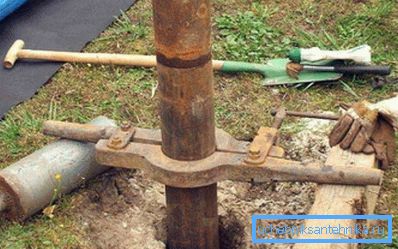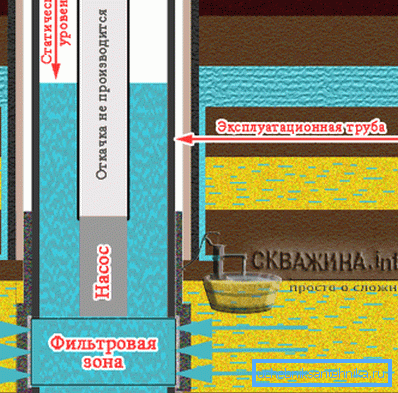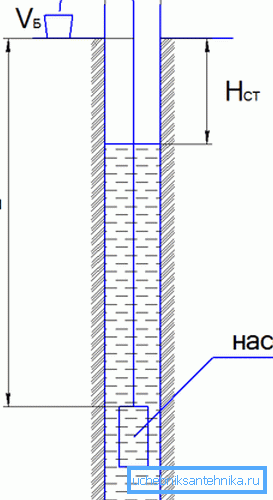What is well debit and how it affects the installation of
First of all, probably, it should be said that the flow rate or debit of a well is its ability to replenish the water pumped out of it within a certain time (one hour is usually taken as a unit of measurement). The power of the hydrophore or submersible pump that you install to supply water to the house and outbuildings will directly depend on this.
How to calculate all this, we will find out below, and also see the thematic video in this article as additional material.

The ratio of the source and pump
Determination of static and dynamic water level

- For wells (wells), there are two measurements that determine the water mark at the source, and the performance of your source will depend on it. After drilling and cleaning, the borehole is not exploited for 1-2 days, as required by the instructions, and after that, the amount of water that has reached the production pipe is measured. This will be a static level, and if everything is done correctly, then the pillar must be above the filter zone, that is, the water intake from the aquifer.
- Now you can measure the dynamic level that will help determine the debit of the well and for this you need to conduct water intake for an hour with a certain intensity (m3/ h) If the intensity of selection will not exceed the source’s ability to replenish, then after a certain time the level will stabilize at a certain level and will be called dynamic. This suggests that for submersible pumps of different capacities such a definition may be different. (See also the article Which pump is better for a well: selection parameters.)
Note. All measurements for static and dynamic levels are made from the ground surface to the water mirror.
Determination of well production

It is necessary to determine the debit in order to clearly understand the possibilities of its exploitation, moreover, not all of them are the same. For example, when drilling a well in the sand, its debit will be much less than that of the artesian counterpart, because the first option affects only the upper layers of the aquifer. For such calculations, use either a powerful pump or airlift..
Note. An airlift is a system that is used when purging wells. Raises water to the surface with compressed air.
Let's try to calculate the flow rate in the well to the water depth of 5 m, where the water intake zone (filter) from the aquifer is at 45 m depth. We take the static level in this production pipe after sludge over 30 m and calculate the total column. So, a pole in the zone of operation we get 50-30 = 20 m.
Suppose that in one hour we pump out 2 m3 water, then measure the distance to the mirror and get 34 m instead of 30m static mark. Hence, the dynamic mark in the production pipe at a flow rate of 2 m3/ h we will be 34 m. Some drillers, using this method, and make it to the passport.
To enter data into the passport, the formula is used: Dt = V / (Hdin-Hstat) * Hw
In this debit in m3/ h denoted by Dt, the pumping rate when measured in m3/ h - V, dynamic level, which is measured immediately after pumping - Hdin, static mark after sludge - Hstat and height of water column - Hw.
In this case, the total flow rate will be 2/4 * 20 = 10 m3/ h, but here there is a possibility of a serious error. As you remember, the calculations involved pumping 4 m of water per hour and it is quite logical to assume that if the pump capacity is doubled, the water column will drop by 8 m during the same period, that is, twice as much. But in practice, this proportion does not exist.
In practice, it turns out that with an increase in the intensity of water intake, the mark in the production pipe will fall much faster than twice. Such an anomaly is obtained under the influence of various factors, and for each well they will change like fingerprints depending on the individual. Therefore, for more accurate calculations, another water intake is made with increased (reduced) intensity.

Suppose that the second measurement we will produce, pumping out the column with an intensity of 3 m3* hour, and the mirror dropped 8 m below the static mark. Now we need to calculate to use a lower dynamic level (38 m) in relation to the high (30 m), using the following formula.
To determine the specific flow rate (denoted by Du), we apply the formula Du = V2-Vone/ H2-Hone. Here is V2 will denote greater pumping rate, and Vone accordingly - less. Exactly h2 will denote the fall of the column at greater intensity, and Hone - fall at less. (See also the article Adapter for a well: installation features.)
With such calculations, we get (3-2) / (8-4) = 0.25, that is, the specific flow rate of the measured well will be 0.25 m3. This suggests that an increase in dynamic level in the production pipe by 1 m will increase the flow rate by 0.25 m.3 (the depth of the pump here should not be below the filter zone).

Now it remains to calculate the real flow rate of our well, just keep in mind that these calculations substitute unrealistic values and you only need to use the formulas given in the article, but not numbers. We use the formula Dt = (Hfilter-Hstat) * Du.
Here Dt will denote the specific flow rate, Hfilter the level of the upper mark of the filter zone (we have - 45m), Hstat static level (we have - 30m) and Du - specific flow rate (we have - 0.25m3/ h) Hence, Dt = (Hfilter-Hstat) * Du = (45-30) * 0.25 = 3.75m3/ h That is, the value of 3.75m3/ h will be our real debit.
Conclusion
Based on the above, we can conclude that the pump that will be used to pump water from the production pipe must be selected in accordance with the value of Dt (in our case - 3.75 m3/ h) That is, it’s not the price of the pump that is important here, but its power corresponding to this figure (you can take it with a reserve) and then you will ensure a normal (uninterrupted) water supply.